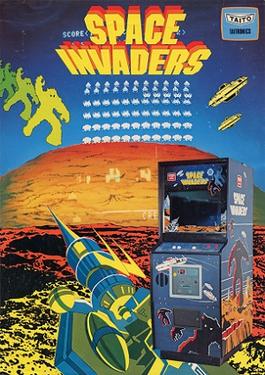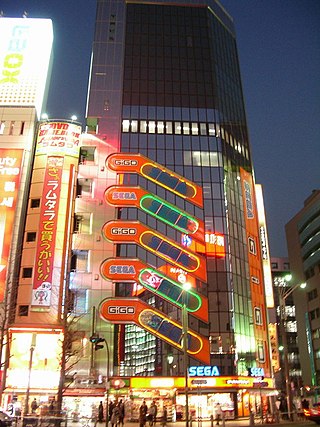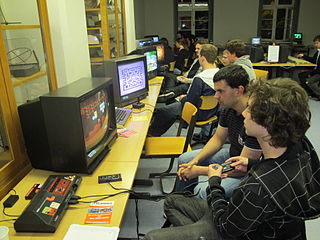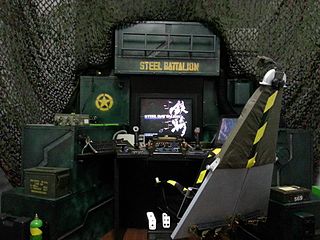
The Atari 2600 is a home video game console developed and produced by Atari, Inc. Released in September 1977 as the Atari Video Computer System, it popularized microprocessor-based hardware and games stored on swappable ROM cartridges, a format first used with the Fairchild Channel F in 1976. The VCS was bundled with two joystick controllers, a conjoined pair of paddle controllers, and a game cartridge—initially Combat and later Pac-Man. Sears sold the system as the Tele-Games Video Arcade. Atari rebranded the VCS as the Atari 2600 in November 1982, alongside the release of the Atari 5200.

A video game, sometimes further qualified as a computer game, is an electronic game that involves interaction with a user interface or input device to generate visual feedback from a display device, most commonly shown in a video format on a television set, computer monitor, flat-panel display or touchscreen on handheld devices, or a virtual reality headset. Most modern video games are audiovisual, with audio complement delivered through speakers or headphones, and sometimes also with other types of sensory feedback. Some video games also allow microphone and webcam inputs for in-game chatting and livestreaming.

The history of video games began in the 1950s and 1960s as computer scientists began designing simple games and simulations on minicomputers and mainframes. Spacewar! was developed by Massachusetts Institute of Technology (MIT) student hobbyists in 1962 as one of the first such games on a video display. The first consumer video game hardware was released in the early 1970s. The first home video game console was the Magnavox Odyssey, and the first arcade video games were Computer Space and Pong. After its home console conversions, numerous companies sprang up to capture Pong's success in both the arcade and the home by cloning the game, causing a series of boom and bust cycles due to oversaturation and lack of innovation.

The Vectrex is a vector display-based home video game console, the only one ever designed and released for the home market, that was developed by Smith Engineering and manufactured and sold by General Consumer Electronics. It was first released for the North America market in October 1982 and then Europe and Japan in 1983. Originally produced by General Consumer Electronics, it was later licensed to Milton Bradley after they acquired the company. Bandai released the system in Japan.

An arcade video game is an arcade game that takes player input from its controls, processes it through electrical or computerized components, and displays output to an electronic monitor or similar display. All arcade video games are coin-operated or accept other means of payment, housed in an arcade cabinet, and located in amusement arcades alongside other kinds of arcade games. Until the early 2000s, arcade video games were the largest and most technologically advanced segment of the video game industry.

Space Invaders is a 1978 shoot 'em up video game developed and published by Taito for arcades. It was released in Japan in April 1978, with the game being released by Midway Manufacturing overseas. Space Invaders was the first fixed shooter and the first video game with endless gameplay and set the template for the genre. The goal is to defeat wave after wave of descending aliens with a horizontally moving laser cannon to earn as many points as possible.

An amusement arcade, also known as a video arcade, amusements, arcade, or penny arcade, is a venue where people play arcade games, including arcade video games, pinball machines, electro-mechanical games, redemption games, merchandisers, or coin-operated billiards or air hockey tables. In some countries, some types of arcades are also legally permitted to provide gambling machines such as slot machines or pachinko machines. Games are usually housed in cabinets.
The video game industry is the tertiary and quaternary sectors of the entertainment industry that specialize in the development, marketing, distribution, monetization, and consumer feedback of video games. The industry encompasses dozens of job disciplines and thousands of jobs worldwide.
A console game is a type of video game consisting of images and often sounds generated by a video game console, which are displayed on a television or similar audio-video system, and that can be manipulated by a player. This manipulation usually takes place using a handheld device connected to the console, called a controller. The controller generally contains several buttons and directional controls such as analogue joysticks, each of which has been assigned a purpose for interacting with and controlling the images on the screen. The display, speakers, console, and controls of a console can also be incorporated into one small object known as a handheld game.
The fifth generation era refers to computer and video games, video game consoles, and handheld gaming consoles dating from approximately October 4, 1993, to March 23, 2006. The best-selling home console was the Sony PlayStation, followed by the Nintendo 64, Sega Saturn, and Atari Jaguar. The PlayStation also had a redesigned version, the PSone, which was launched on July 7, 2000.
1999 saw many sequels and prequels in video games, such as Heroes of Might and Magic III, System Shock 2, Legacy of Kain: Soul Reaver, Final Fantasy VIII, Age of Empires II, Crash Team Racing, Spyro 2: Ripto's Rage!, Grand Theft Auto 2, Resident Evil 3: Nemesis, Chrono Cross, Unreal Tournament, Pokémon Gold and Silver, and Donkey Kong 64, along with new titles such as Super Smash Bros., Silent Hill, Syphon Filter, Driver, EverQuest, Homeworld, Tony Hawk's Pro Skater, and Planescape: Torment.
1996 saw many sequels and prequels in video games, such as Super Mario 64, Duke Nukem 3D, Street Fighter Alpha 2, Super Mario RPG, King's Field III, Virtua Fighter 3, along with new titles such as Blazing Heroes, NiGHTS into Dreams..., Crash Bandicoot, Pokémon Red/Green/Blue, Resident Evil, Dead or Alive, Soul Edge, Quake and Tomb Raider.

An electronic game is a game that uses electronics to create an interactive system with which a player can play. Video games are the most common form today, and for this reason the two terms are often used interchangeably. There are other common forms of electronic games, including handheld electronic games, standalone arcade game systems, and exclusively non-visual products.

Retrogaming, also known as classic gaming and old school gaming, is the playing and collection of personal computers, consoles, and video games from earlier decades. Usually, retrogaming is based upon systems that are outmoded or discontinued, although ported retrogaming allows games to be played on modern hardware via ports, emulations or compilations. It is typically for nostalgia, preservation, or authenticity. A new game could be retro styled, such as an RPG with turn-based combat and pixel art in isometric camera perspective, as well as chip-tune styled music.
In the history of video games, the second-generation era refers to computer and video games, video game consoles, and handheld video game consoles available from 1976 to 1992. Notable platforms of the second generation include the Fairchild Channel F, Atari 2600, Intellivision, Odyssey 2, and ColecoVision. The generation began in November 1976 with the release of the Fairchild Channel F. This was followed by the Atari 2600 in 1977, Magnavox Odyssey² in 1978, Intellivision in 1980 and then the Emerson Arcadia 2001, ColecoVision, Atari 5200, and Vectrex, all in 1982. By the end of the era, there were over 15 different consoles. It coincided with, and was partly fuelled by, the golden age of arcade video games. This peak era of popularity and innovation for the medium resulted in many games for second generation home consoles being ports of arcade games. Space Invaders, the first "killer app" arcade game to be ported, was released in 1980 for the Atari 2600, though earlier Atari-published arcade games were ported to the 2600 previously. Coleco packaged Nintendo's Donkey Kong with the ColecoVision when it was released in August 1982.
Videotopia is a travelling science museum exhibition documenting the history of video games. Originally created by Keith Feinstein, it is based on a larger collection of video game machines, now housed at The Strong in Rochester, New York.

The Computerspielemuseum is a German video game museum founded in 1997. From 1997 to 2000, it had a permanent exhibition in Berlin. Afterward, it became an online-only museum. In 2011, the museum reopened its permanent exhibition in Berlin's neighborhood of Friedrichshain, on Karl-Marx-Allee. During the first month of its permanent exhibition, it had 12,000 visitors.

The National Videogame Museum is a video game museum about the history of video games and the video game industry, located in Frisco, Texas. Opened in 2016, the museum includes classic video game arcade machines in an arcade setting, games on different video game consoles in a living room setting, games on historic computers, exhibits on the history of the industry, artifacts and memorabilia about the video game industry. One of the museum's goals is to have visitors experience the games, so there are many interactive displays which feature playable games.

The Video Game Museum of Rome (VIGAMUS) is an interactive video game museum that displays the history of video games. The first official announcement for the museum was at the Italian Videogame Developer Conference (IVDC) in 2010. The museum opened its doors to the public in October 2012. VIGAMUS is among the founding members and promoters of EFGAMP, the European Federation of Game Archives, Museums, and Preservation Projects. This federation aims to find new opportunities of digital preservation, with a particular attention to video games.
















